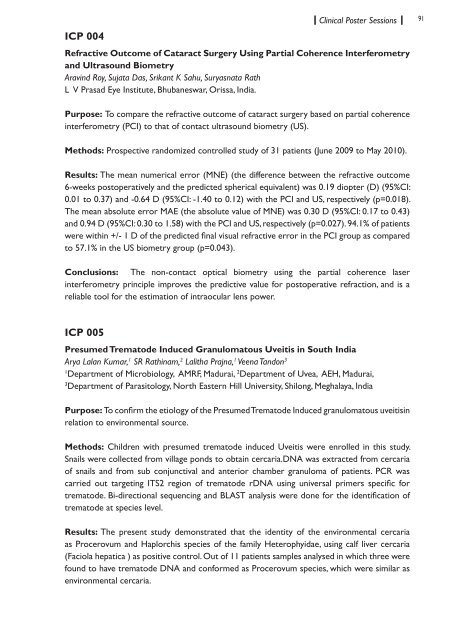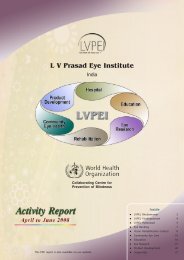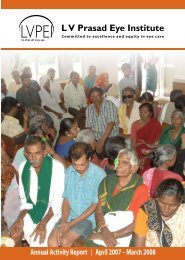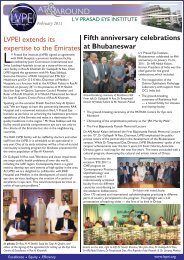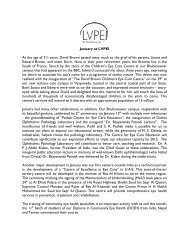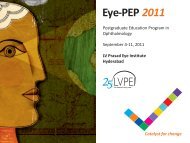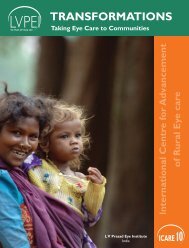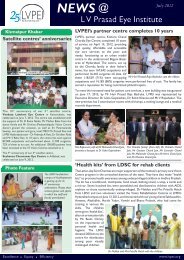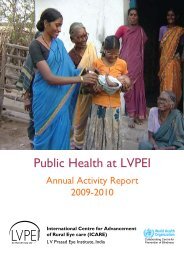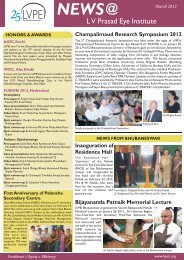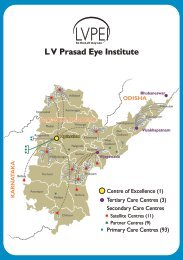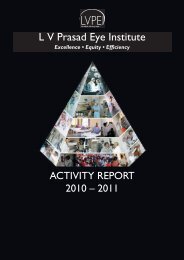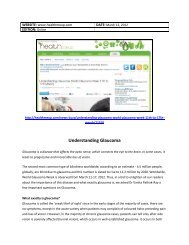IERG Abstracrt Book.indd - LV Prasad Eye Institute
IERG Abstracrt Book.indd - LV Prasad Eye Institute
IERG Abstracrt Book.indd - LV Prasad Eye Institute
You also want an ePaper? Increase the reach of your titles
YUMPU automatically turns print PDFs into web optimized ePapers that Google loves.
ICP 004Clinical Poster SessionsRefractive Outcome of Cataract Surgery Using Partial Coherence Interferometryand Ultrasound BiometryAravind Roy, Sujata Das, Srikant K Sahu, Suryasnata RathL V <strong>Prasad</strong> <strong>Eye</strong> <strong>Institute</strong>, Bhubaneswar, Orissa, India.91Purpose: To compare the refractive outcome of cataract surgery based on partial coherenceinterferometry (PCI) to that of contact ultrasound biometry (US).Methods: Prospective randomized controlled study of 31 patients (June 2009 to May 2010).Results: The mean numerical error (MNE) (the difference between the refractive outcome6-weeks postoperatively and the predicted spherical equivalent) was 0.19 diopter (D) (95%CI:0.01 to 0.37) and -0.64 D (95%CI: -1.40 to 0.12) with the PCI and US, respectively (p=0.018).The mean absolute error MAE (the absolute value of MNE) was 0.30 D (95%CI: 0.17 to 0.43)and 0.94 D (95%CI: 0.30 to 1.58) with the PCI and US, respectively (p=0.027). 94.1% of patientswere within +/- 1 D of the predicted final visual refractive error in the PCI group as comparedto 57.1% in the US biometry group (p=0.043).Conclusions: The non-contact optical biometry using the partial coherence laserinterferometry principle improves the predictive value for postoperative refraction, and is areliable tool for the estimation of intraocular lens power.ICP 005Presumed Trematode Induced Granulomatous Uveitis in South IndiaArya Lalan Kumar, 1 SR Rathinam, 2 Lalitha Prajna, 1 Veena Tandon 31Department of Microbiology, AMRF, Madurai, 2 Department of Uvea, AEH, Madurai,3Department of Parasitology, North Eastern Hill University, Shilong, Meghalaya, IndiaPurpose: To confirm the etiology of the Presumed Trematode Induced granulomatous uveitisinrelation to environmental source.Methods: Children with presumed trematode induced Uveitis were enrolled in this study.Snails were collected from village ponds to obtain cercaria.DNA was extracted from cercariaof snails and from sub conjunctival and anterior chamber granuloma of patients. PCR wascarried out targeting ITS2 region of trematode rDNA using universal primers specific fortrematode. Bi-directional sequencing and BLAST analysis were done for the identification oftrematode at species level.Results: The present study demonstrated that the identity of the environmental cercariaas Procerovum and Haplorchis species of the family Heterophyidae, using calf liver cercaria(Faciola hepatica ) as positive control. Out of 11 patients samples analysed in which three werefound to have trematode DNA and conformed as Procerovum species, which were similar asenvironmental cercaria.


